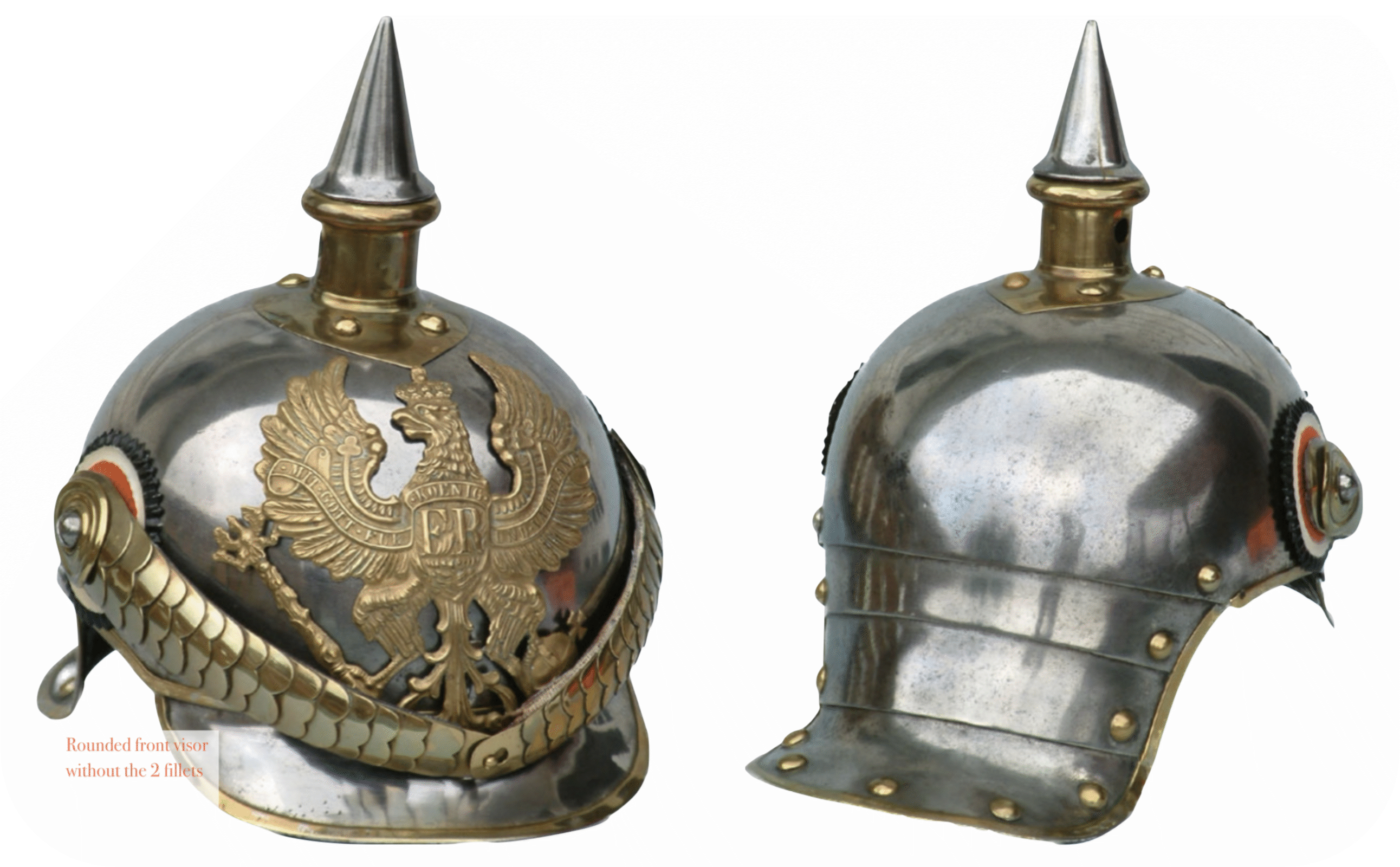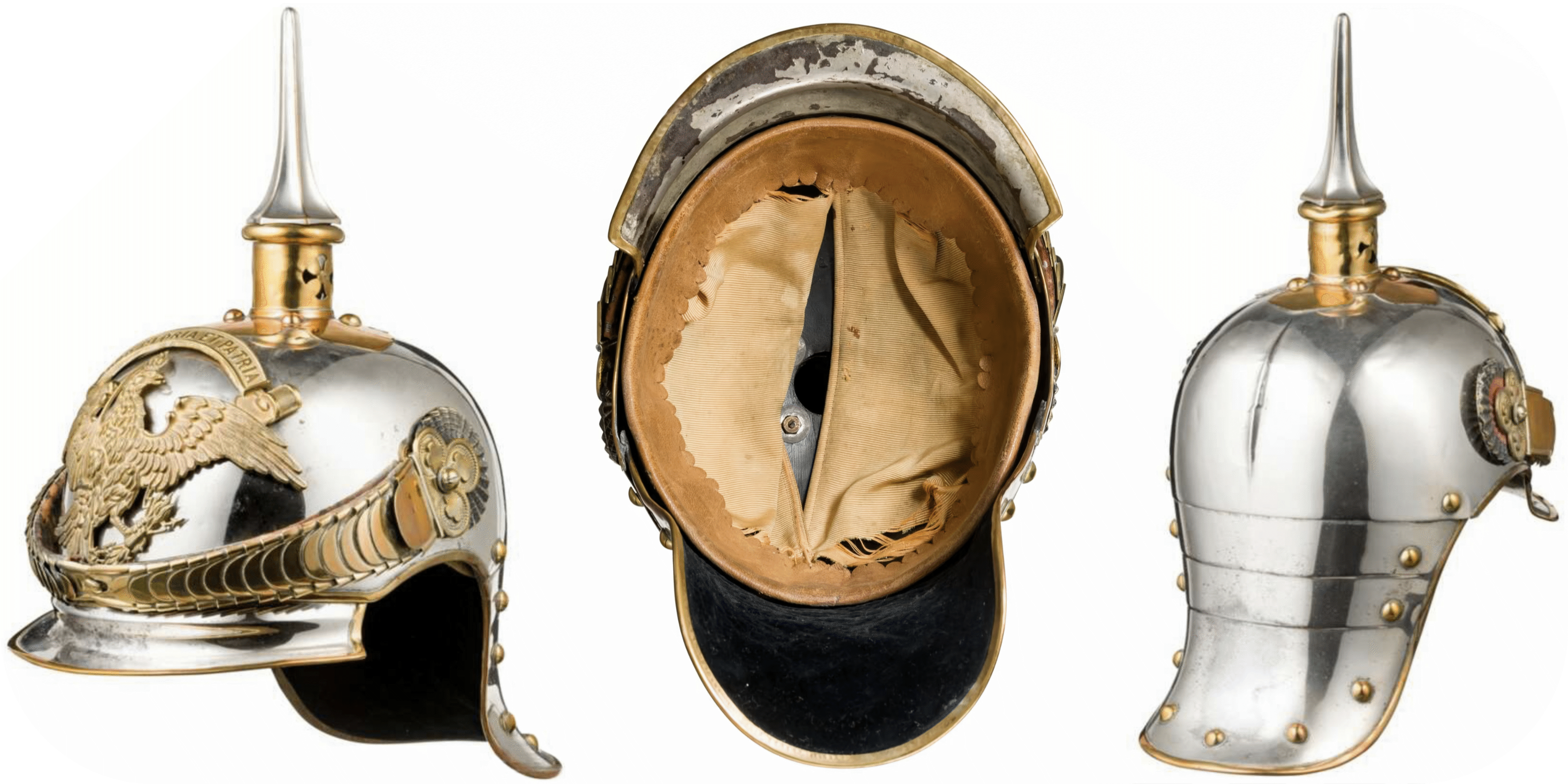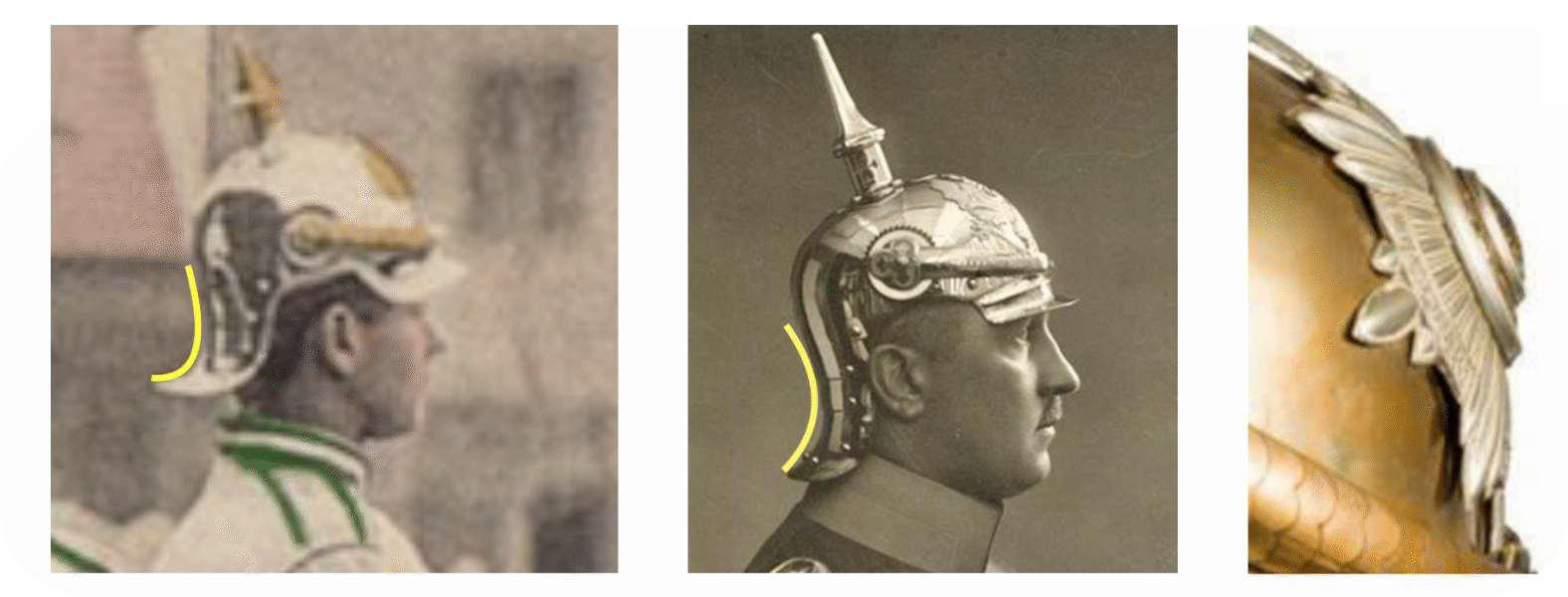The metal Pickelhaube M1889 (development until 1914)
1889 - Cuirassiers
During the Franco-Prussian War of 1870/71, several problems with the cuirassier's equipment became evident. The cuirass no longer offered protection against modern rifles, the old Brandenburg boots were a handicap when fighting on foot, and the helmet had an non-optimal shape that was an obstacle for the introduction of a carbine into the armament of the cuirassiers. Despite these disadvantages, Kaiser Wilhelm I. resisted any changes to the uniform or equipment, as he was very taken with the appearance of his cuirassiers. For this reason, the necessary modifications to the uniform were made after his passing, by AKO of 28.1.1889. With these changes, the M1889 helmet lost much of its original grace, but the appearance was in keeping with the taste of the time.
- Since all cuirassiers were now armed with a carbine, the front visor of the helmet had to be adapted. The squared shape was an obstacle when shooting the carbine, which is why the double fluted front visor was replaced by a round one, slightly curved for the enlisted men. (Fig. 1, left). As a result, the front visor was only 4.5 - 4.8 cm high and 14.0 - 17.8 cm wide (the width of the M1889 can only be measured using imaginary corners).
- The vertical rib on the back of the helmet shell was also eliminated (Fig. 1, right). However, the 17 large bolts for assembly the helmet were not changed.
- The visor trims were still 0.5 cm wide, the connecting piece on the edge between the front and rear visor still only 0.4 cm. The golden edge trims were made of brass as usual, the silver ones of nickel silver.
- The guard star probably remained 14.0 cm in size (measured 13.0 - 14.0 cm). But the height of the helmet eagle was reduced to 11.0 cm. As on the helmet eagle of the later introduced leather helmet M1895, 2 wire loops were soldered to the back of the emblem, through which it could be fixed to the helmet shell by means of 2 leather wedges (perhaps this happened towards 1895, unfortunately I couldn’t determine the exact date of introduction). However, no brass bushes were used in the helmet shell of the metal helmets, as was the case with the M1895. The guard star continued to be attached with the two threaded pins and square nuts.
- The inside of the rear visor was no longer covered with leather, but only painted black (Fig. 2).
- The chinscales, made of tombac or brass, were 3.5 cm wide at the back and 1.6 cm wide at the front.
- The overall height of the smooth spike was reduced to around 9.0 cm, compared to 11.0 cm for the Guard du Corpes. As before, the neck of the spikebase had 2 ventilation holes. In contrast to the metal changes made to the other parts, the metals were retained here as described for the M1843.
- The helmet of the enlisted men weighed about 700 - 800 g.
Officers:
After 1870, the officer's helmet began to differ more from the enlisted helmet. The officer's helmet M1889 had the following characteristics in addition to the enlisted helmet:
- The more bowl-shaped helmet shell had a clear height of 11.0 cm and the helmet was still held together with 17 large bolts. The trims were still 0,5 cm wide for officer helmets.
- The 5.0 cm high squared front visor kept its shape with the double fillet and was lined from the inside with thin green Saffian leather.
- The 12.0 cm high rear visor was still made of one sheet with 2 horizontal ribs, making it look as if it were 3 parts. The inside was dressed with black velvet.
- The total height of the spike was again increased to about 13.0 - 14.0 cm, after having been only about 10 cm high in the meantime. The officers' parade eagle corresponded in shape and size to the enlisted men's eagle, except that it was more finely chased and silver-plated.
- The guard star and the helmet eagle were identical in size to those on the enlisted men's helmets, except that they were more finely chased and silver or gold-plated.
- The chinscales were slimmer than the previous designs at 2.7/1.4 cm and not everyone was pleased with the new look. The chinscales of the officers of the „Leib“ cuirassier regiment No. 1 kept their unique design (Fig. 3) and measured 3.2/1.75 cm.
- The cockades still had a diameter of 6.5 cm. Only the officers of the „Leib“ cuirassier regiment No. 1 again had an unique design. Their cockades were designed in the old Hessian style and had a diameter of only 5.0 cm with a flattened section. However, since the mounting hole in the cockade was set off-center and the cloverleaf-shaped rosette cleverly masked it, the cockade on the helmet looked like a complete and round disk (Fig. 3).
- The helmet liner became much lighter. As with the leather helmets, it consisted of a sweatband of fine sheepskin or goatskin about 5.0 - 6.0 cm wide, which was lined with silk rip. This was split in the middle and held in shape with 2 twigs of brushwood (Fig. 3 center).
- The weight of the officer's helmet was on average only about 600 - 700 g.
A short excursion about the officers' helmets from 1870 to 1918
In the 1880s, after the officer's helmet became lower and lower, the rear visor strongly protruded from the back of the wearer's head (Fig. 4 left). In earlier helmet designs, on the other hand, it was tight against the back of the neck (Fig. 4 middle). This was mainly due to the height of the front visor, since the lower edge of the visor was prescribed to be at the level of the eyebrows. Because of the higher visors, the helmet therefore had to be pushed far back in earlier designs, which naturally also pushed the rear visor close to the neck. The lower helmet, on the other hand, could be worn upright, causing the rear visor to stand out so unattractively.
In the years around 1890, the shape of the helmet changed and although the front visor again became slimmer, the rear visor was again closer to the neck line. Around 1900, the officer's helmet reached its highest level of elegance (Fig. 3):
- The front visor was still double fluted, but in a modern squarer style.
- The long rear visor closely followed the officer's head and neck (Fig. 4, center).
- The vertical rib at the back of the shell was very prominent.
- The guard helmets also had the guard star adapted to the fashionable spirit of the times. The white enameled ring with the golden inscription "SUUM CUIQUE" and the green laurel branch was three-dimensional and emerged conically from the plane of the guard star. The inner golden surface with the enameled black eagle stood out even more, making it look particularly handsome (Fig. 4 right).
This shape was kept until 1918. During World War 1, it was worn with a field gray cover.
1894
On May 18, 1894, an AKO ordered that cavalry units should also wear chinscales with the M91 fastening system on their metal helmets. Thus the helmet type M1894 was created for enlisted men. In contrast to the leather helmets, the M91 rosettes were not covered with a decorative cap, since this would have looked too massive and thus not attractive due to the wider chinscales of the metal helmets (Fig. 5).
1897




